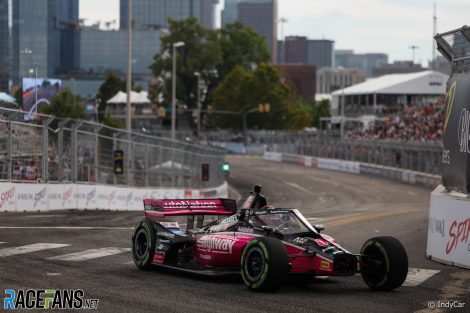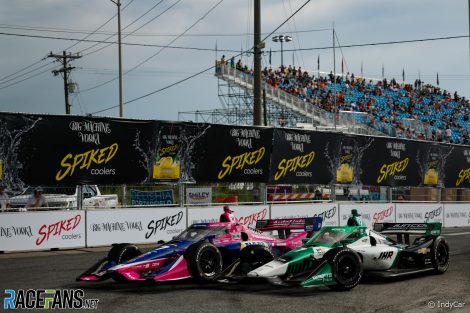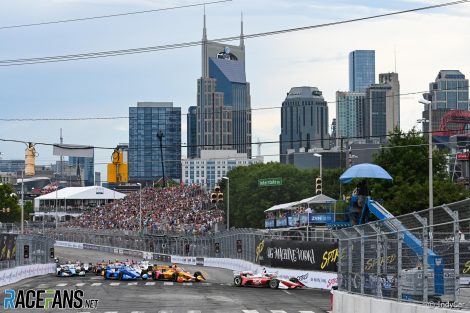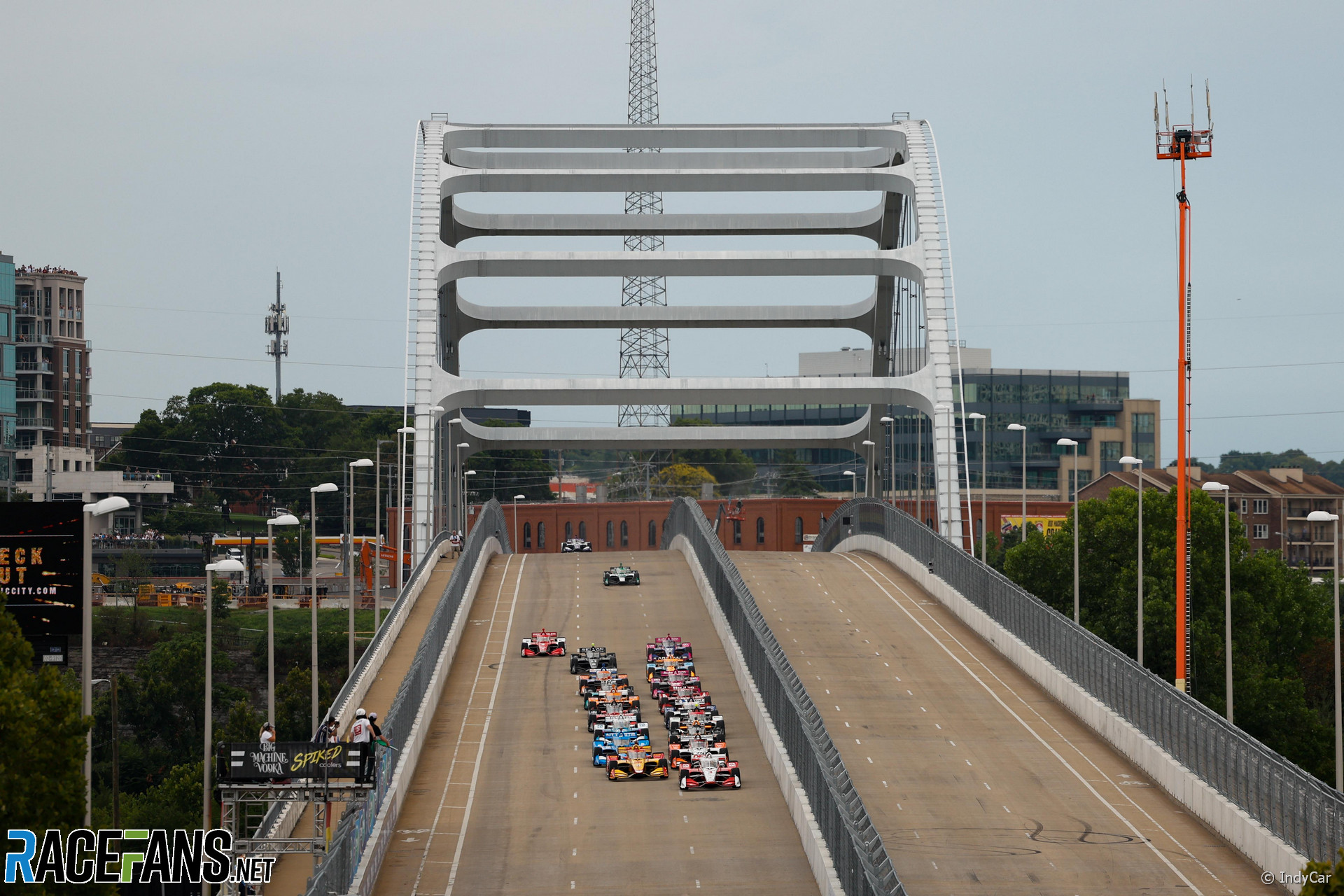Oh, Nashville. Even after modifications to the downtown street circuit, even with a year of experience baked into the cache of teams and most drivers, the 2022 IndyCar Music City Grand Prix was as much of a carnage-riddled mess as the inaugural edition.
From the feedback to our report of this race, it seems many people have made up their mind about IndyCar’s newest street circuit in one of the fastest-growing cities in the United States. “Crash-fest” was one descriptor. “Farce” was another, along with “garbage”.Some already came to this conclusion after the first incident-packed IndyCar race a year ago, but after the year-two repeat, this sentiment has grown louder and impossible to ignore. Nashville has a three-year contract with IndyCar that ends in 2023, but does it have a future beyond that? Will it even make it that far?
It’s impossible to ignore a pattern over two years where over 40 percent of the race distances have been run under the safety car, and both races have been red-flagged due to accidents in the final five laps. Over the first and second Music City grands prix produced a combined 17 caution periods covering 69 out of a possible 160 racing laps (over 43%).

Nashville’s reputation for carnage is said to be a product of the circuit. The southbound run across the Korean War Veterans’ Memorial Bridge leads into a heavy braking zone and potential passing opportunity into turn four, which then feeds into a single-file choke point through turn seven. This was a part of the course which was begging for a track-blocking incident, like the seven-car pile-up that happened on lap 26 of Sunday.
Scott Dixon – who survived the turn seven melee on Sunday to win – said changes made to address the circuit’s biggest trouble spots after the first race were a net positive. “The adjustments that they did this year, especially the transitions on and off the bridge, were huge,” said the six-time IndyCar champion. “I think they did a very good job on opening the sight line in a lot of places. Especially turn 11 and even turn two and turn three.”
Advert | Become a RaceFans supporter and
Dixon also hinted at changes that could be in the works if the race sticks around long enough to see construction of a luxury apartment building along Peabody Street completed. “I think some changes will come in the future, for that four-through-eight section once that construction is done. They’re talking about, maybe we’ll go up another block and then take a left, which would be great for a passing zone as well.”

When the field wasn’t under the control of IndyCar veteran turned pace car driver Oriol Servia, the racing product at Nashville was otherwise solid. A bit processional, sure, but not out of the ordinary when compared to other, longer-serving IndyCar street races at Long Beach, Toronto, and St. Petersburg. It was difficult, but still possible to make on-track overtakes without causing a crash.
This was even after recurring rain and lightning storms throughout the weekend made it impossible for rubber to build up on the racing line – along with disrupting the weekend schedule, and delaying the green flag by 90 minutes on Sunday.
IndyCar has a race in a growing major American city that is attractive to tourists from around the world, and while “racing over a bridge” may feel like a played-out gimmick for the event’s detractors, the Music City Grand Prix, for better or worse, offers something unique on the IndyCar calendar. It is more inspired than what the Detroit Grand Prix’s new Renaissance Centre layout appears to offer at first glance for 2023 and beyond.
But even if there are quality of life improvements in the pipeline, it’s hard to see a future beyond next year for this event.
Advert | Become a RaceFans supporter and
Attendance figures for the 2022 Music City Grand Prix haven’t been announced, but it’s generally accepted that the inaugural event drew 110,000 spectators across three days of racing. Maintaining big crowds for a new or returning IndyCar race is hard.

If the shots of visibly less-populated grandstands are reflected in the 2022 attendance figures, that does not bode well for the chances of Nashville being extended beyond 2023. The unhelpful weather played its part, sure, delaying the starts of both qualifying and the race. But the combination of the first-year novelty factor wearing off, and a growing reputation of being a sub-par event for pure racing, cannot be ignored as potential factors in a dip in attendance.
This is before even considering the issues last year where spectators paid for tickets in grandstands that had yet to be completed when the weekend started last year, or the inadequate facilities that were on offer to the media covering the event on location this weekend.
As it stands, there will be at least one more Music City Grand Prix next year. Beyond that, the trend is not looking good for the race to stay around long-term. Given its obvious shortcomings as a racing circuit, it seems few would lament its passing.
IndyCar
- F2 champion Pourchaire to make IndyCar debut for McLaren at Long Beach
- IndyCar’s packed pit lanes “a good problem to have” with 29-car field
- How to watch the Chinese GP, IndyCar at Long Beach and WEC at Imola
- Prema announce move into IndyCar with new two-car team in 2025
- Palou dominates IndyCar’s Thermal Club $1 Million Challenge





Electroball76
10th August 2022, 8:01
Maybe they could design courses that were specially built for high speed racing. With wide tracks, sweeping corners, safe run-off and barriers.
BasCB (@bascb)
10th August 2022, 9:36
You mean something like, I don’t know, let’s call them “permanent race tracks”? What a novel idea, it might even work! But then you would have be build hotels nearby, and camping sites and infrastructure to get there too.
Marvin The Martian (@marvinthemartian)
10th August 2022, 8:10
I watched some of the highlights on YouTube and, apart from the abysmal track and woeful racecraft, the thing that surprised me the most was the almost complete lack of fans in the stands around the track.
If it has no future, it is almost certainly due to a lack of interest
some racing fan
10th August 2022, 9:46
There were a bunch of people at the first corner after the bridge, but they then left after the start.
some racing fan
10th August 2022, 9:47
Quite honestly at this stage they should really consider the Nashville oval, if they can’t change the track layout.
Stephen Higgins
10th August 2022, 13:34
+1
JohnH (@johnrkh)
10th August 2022, 10:02
Bernie Ecclestone wanted a race across the Sydney Harbour Bridge and around the Rocks a small section of Sydney consisting of old terrace houses and pubs and really narrow streets near Circular Quay.
I’m so glad the premier of the day told him thanks but no thanks. It would have been an absolute disaster.
Don
10th August 2022, 14:34
It’s impossible for Nashville not to be crashville as tight as it is. Yes, lots of crashes and cautions but it is a unique aspect of the calendar and is entertaining. They will (should) continue to make track modifications to decrease the amount of carnage.
Griffin
10th August 2022, 17:03
I imagine that the construction of a new $2+billion stadium for the Titans adjacent to their current one will also have a slight impact on the future of this venue.
thegamer23
11th August 2022, 21:27
Most of the crashes were due poor drivers standards tho.